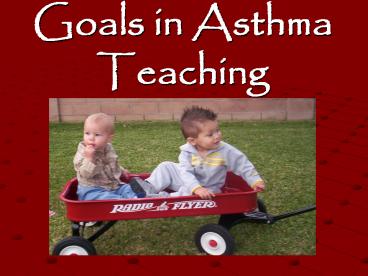Goals in Asthma Teaching PowerPoint PPT Presentation
1 / 34
Title: Goals in Asthma Teaching
1
Goals in Asthma Teaching
2
What Is Asthma
Signs and Symptoms
Proper use of Medication
Action Plan for Home Use
3
What is Asthma?
- In children, asthma is a chronic, life
threatening - disease, that makes it hard to breathe.
- Asthma causes
- Swelling
- Inflammation
- Twitchiness
- In the lining of the airways that lead to the
lungs. - When Asthma flares up, the airways become tight
and narrower, making It hard to breath.
4
These flare-ups are called asthma attacks or
exacerbations
5
- What Causes Asthma?
- Experts do not know exactly what causes
- asthma
- Asthma runs in families
- Asthma is more common in people with allergies
- Pollution may cause asthma or make it worse
6
Asthma Symptoms
- Wheezing
- Persistent Cough
- Tightness in the chest
- Shortness of breath
- Interrupted sleep
- Quickly tires during exercise
7
How Asthma is Triggered
- Allergens
- Exercise
- Pollution
- Cold Air
- Viral Infection
- Sinus Infection
- Irritants
8
Irritants and Allergens
Health InfoNet INC.
9
Diagnosis
- Physical examination
- Thorough history
- Spirometry
- Peak expiratory flow
- X-ray
- Allergy testing
10
- Physical Exam
11
Symptom History
- Mild intermittent asthma
- Symptoms (on average two days a week)
- Persistent asthma
- Mild persistent (symptoms more than two days a
week) - Moderate persistent (Daily symptoms)
- Persistent asthma (Having to LIMIT daily
activities) - Frequent respiratory illnesses
12
- Spirometry
13
- Peak Flow Meter
- Stand Tall
- Take deep breath
- Insert mouth piece
- Close mouth firmly
- Blow hard and fast
- Read RED indicator
- Repeat three times
14
- X-ray
15
- Allergy Testing
16
Common Medications In Asthma Management
17
- Medications
- Inhaled Steroids
- Control
- Daily prevention by blocking inflammation and
reducing sensitivity of air ways.
18
- Long Acting Bronchodilator
- Control
- Bronchodilator keeps airways open up to 12 hours.
19
- Leukotriene Modifier
- Control
- Blocks cellular response to inflammation.
20
- Cromolyn
- Control
- Prevents inflammation and relaxes bronchial
muscles
21
- Short Acting Beta 2- agonist
- Rescue Medication
- Dilates airways quickly
22
- Oral Steroids
- Added Rescue Medication
- Reduces inflammation and mucus
- Helps airway respond to Beta 2-agonist
23
- Antihistamines
- Prevention
- Prevents Sinus Trouble or Rhinitis
- which may trigger asthma symptoms
24
- Nasal Spray
- Prevention
- Prevents sinus trouble or rhinitis
- which may trigger asthma symptoms
25
- Proper use of equipment
- IS
- essential in
- asthma management
26
Nebulizer
- Infant Mask
Toddler Mask
Mouth Piece (school age adult)
27
Meter Dose Inhaler
- Infant
Infant-aerochamber with mask
School age- aerochamber
Adolecent to adult
28
- A Plan
- To Live By
- The key to successful management of asthma is
obtained through - Proper Parental Education
29
- TEACH PARENTS
- To avoid asthma triggers
- Specific medications prescribed for their child.
- Proper technique in administering medication
- Signs and symptoms of asthma exacerbation
- Technique to avoid hospitalization with mild
exacerbation - Goals of management
30
- Asthma Action Plan
AstraZeneca2005
31
(No Transcript)
32
(No Transcript)
33
(No Transcript)
34
Goals of Management
Living a happy and active life

